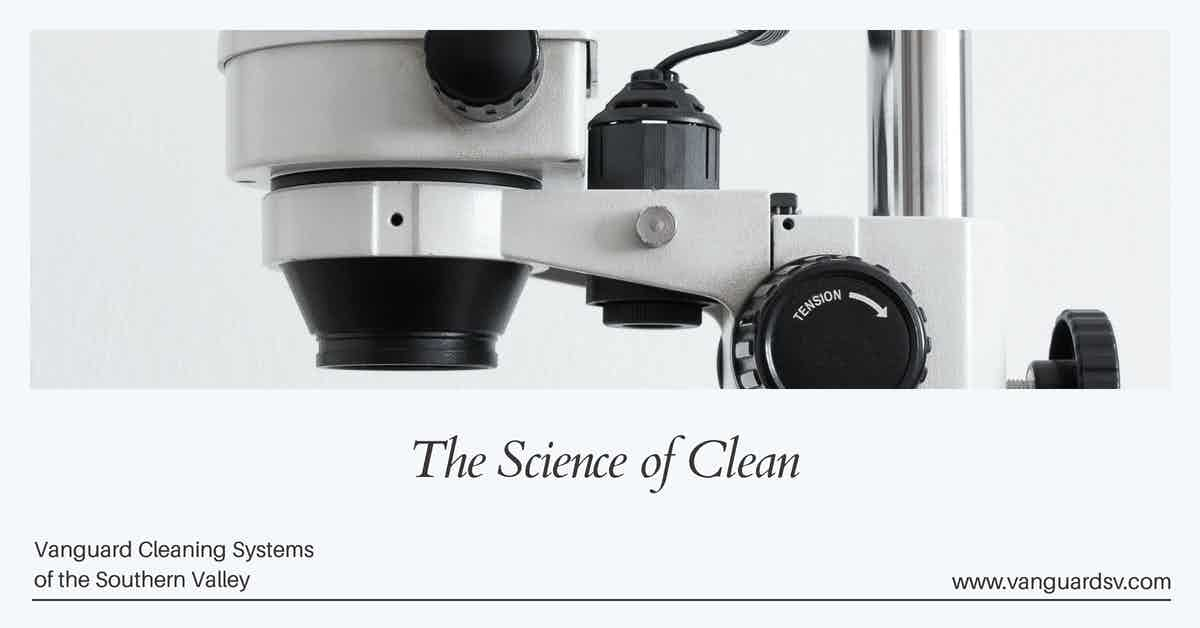Cleaning is a scientific process that involves documenting a detailed plan based on a sound theory, applying that theory in real-world scenarios, observing and recording the results, and then adjusting the application of the theory to produce more desirable outcomes based on the observations.

Doing Cleaning Work Scientifically
High-performance custodial work adheres to the scientific method, resulting in superior facility hygiene and occupant health.
A well-designed cleaning process focuses on efficiently and effectively removing soil, germs, bacteria, and fungi from surfaces.
Custodial work is a process with clearly defined, actionable, and measurable tasks.
Therefore, it requires thoughtful design to maximize quality and minimize cost.
Thus, a good cleaning program is first created on paper, pilot-tested to ensure that it is devoid of inefficient tools and equipment.
The result of a good cleaning program is that cleaning specialists do not perform redundant tasks nor expend unnecessary energy and organizations achieve higher cleaning quality while minimizing cleaning costs.
Choosing the Right Cleaning System
In general, the approach toward commercial cleaning can be broken up into two distinct methods--zone cleaning and team-cleaning.
In zone cleaning, one individual is typically assigned to a specific area and is responsible for all aspects of the process.
In team-cleaning, a group of custodians is responsible for cleaning all zones, and each individual is assigned a specific task or surface.
In most cases, especially in larger facilities, team-cleaning is considered more efficient for several reasons:
- Individual specialties are easier to leverage, and;
- Less equipment is required.
However, not all scenarios are identical, and it is important for organizational managers to test various methods and apply the approach that produces the best outcome.
Equipment Choice
Equipment choice is critical for obtaining high-quality outcomes while protecting the health and safety of custodial service providers.
The idea behind cleaning science measurements is to come up with the most productive and effective means of cleaning.
Cleaning science looks at soil removal over time.
By testing before and after cleaning, custodial operations can pinpoint processes and equipment that clean well in less time, which can boost productivity and reduce labor costs.
For example, a process that puts less dust into the air directly impacts labor needs, because less follow-up dusting will be required.
Examples of highly-effective commercial cleaning equipment that have produced desirable cleaning outcomes include:
- Commercial backpack vacuums produce less noise and reduce the strain on the service provider, which translates into the ability to work longer and more effectively.
- Pre-packed cleaning solutions or chemical management systems reduce the chance for toxic chemical exposure and eliminate the guesswork in mixing products.
- Microfiber is more effective at cleaning and removing soil and surface germs and bacteria than cotton alternatives.
- Electrostatic disinfection appliances are more efficient and effective at applying disinfectant products across multiple surfaces and significantly reduce the time necessary to fully disinfect large, complex facilities.
Task Assignments
Clearly defining tasks for teams and individuals is critical for producing highly desirable outcomes and effectively measuring results.
A good place to start is establishing a cleaning checklist based on defined zones throughout the facility.
Color-coding zones with equipment that are assigned to individual team members have also been shown to increase productivity while eliminating cross-contamination.
Detailed documentation of cleaning tasks also aids in training new team members and prevents the loss of critical skills and knowledge in the event a team member leaves the organization.
Additional benefits to a detailed cleaning checklist and documentation include:
- Simplified work and task scheduling, and;
- Defined communication protocols and requirements.
References & Resources
Takeaway
Approaching facility cleaning with the scientific method allows for adaptation to constantly changing occupant needs and environmental factors while ensuring consistently high outcomes.
Outsourcing, especially for smaller blue-collar businesses that lack the resources to house and train a sufficiently sized and equipped staff, is a proven method for delivering cost-effective custodial services and ensuring the highest standards of facility cleanliness and occupant safety.
If you would like more information regarding the effectiveness of high-performance infection prevention and control measures, or if you would like to schedule a free, no-obligation onsite assessment of your facility's custodial needs, contact us today for a free quote!
In Bakersfield, CA, call (661) 437-3253
In Fresno, CA, call (559) 206-1059
In Valencia CA, or Santa Clarita CA, call (661) 437-3253
In Palmdale, CA or Lancaster, CA, call (661) 371-4756

